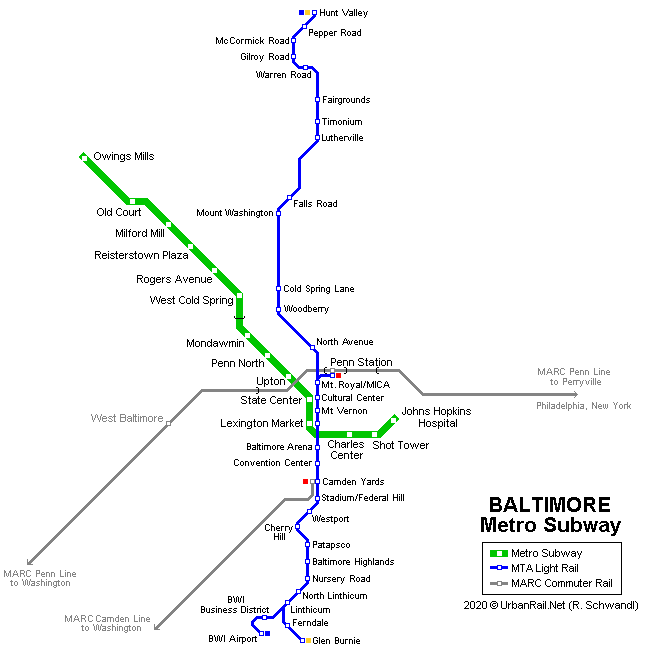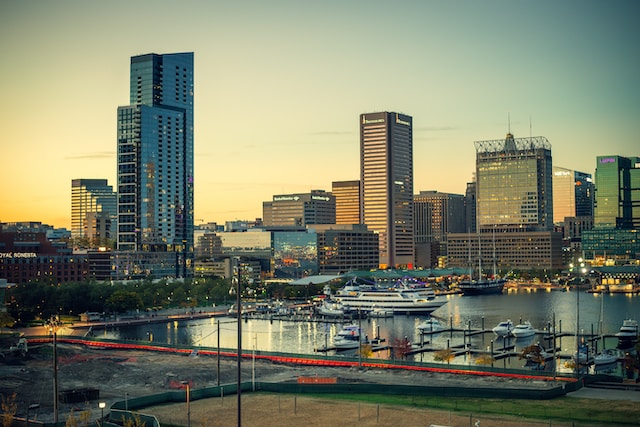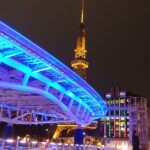The Maryland Transit Administration (MTA), which runs the city’s bus, light rail, and subway systems, provides public transportation in Baltimore. The city also offers the MARC commuter rail service and the Charm City Circulator, a free shuttle service run by the city. The majority of the city’s neighborhoods are serviced by the MTA’s more than 100 bus lines. There are four lines in the light rail network that connect Camden Yards with Hunt Valley, Owings Mills, Cromwell, and BWI Airport. The Metro SubwayLink and the Baltimore Light RailLink are the two lines that make up the subway system. From Owings Mills to Camden Yards, both lines are available. The Charm City Circulator runs four routes in and around downtown Baltimore that are designated by color. With stations along the way, the MARC commuter rail service connects Baltimore and Washington, D.C.
Metro system in Baltimore – Basic information
The Baltimore Metro system is a vast network of public transit that makes it simple to get around the city and its environs. It comprises of the 14-station Metro Subway, 33-station Light Rail, and the Baltimore Streetcar Museum, which provides a historical perspective on the city’s previous streetcars. The primary connection connecting Owings Mills with Johns Hopkins Hospital is the Metro Subway. From Hunt Valley, the Light Rail travels to Cromwell Bridge Road and BWI Airport. It links a number of communities, including Canton, Federal Hill, the Inner Harbor, and Fells Point. For anybody interested in Baltimore’s transportation history, a visit to the streetcar museum is a must. It has a number of interactive exhibits as well as restored streetcars from the early 1900s.
The lines of the Baltimore subway system
The city of Baltimore and the territories around it are served by the Baltimore Metro Subway, an underground rapid transit system. The Metro Subway Red Line and the Metro Subway Green Line are the two primary lines in the subway system. The Johns Hopkins Hospital is accessible via the Red Line from Owings Mills and the Green Line from Patapsco.
Baltimore Light RailLink
Along its journey, the Baltimore Light RailLink stops at a total of 22 stations. It serves the communities of Owings Mills, Reisterstown Plaza, Pikesville, Mount Washington, Cedonia, North Avenue, State Center, Lexington Market, and North Avenue in addition to Johns Hopkins Hospital. Other communities that it serves include Lexington Market and North Avenue. The Red Line is comprised of ten different sections, five of which are underground and five of which are above ground.
The Metro SubwayLink (Green Line)
Eleven stops are spread out throughout the Green Line’s course, which is 8.6 miles long. Among the neighborhoods that it serves are Patapsco, Violetville, Westport, Mount Clare, Carroll Park, Camden Yards, Inner Harbor, and Johns Hopkins Hospital. Also included in this list are Camden Yards and Inner Harbor. The Green Line is comprised of five different sections total: three underground and four above-ground..
Numerous bus routes that serve the station locations of the Metro Subway are also available. The Maryland Transit Administration runs the bus services that connect the stations to other areas of the city along the Metro Subway.
Map of Baltimore Metro 2023 – Free Download in PDF

Click and download the map of the Baltimore underground system for 2023
The Baltimore City Map Anyone who lives in or visits Baltimore should have access to Metro 2023. It offers a thorough overview of the city’s public transit system as well as significant sights. It is simple to view and print for reference thanks to the free download in PDF format. All of the city’s subway and light rail lines, as well as bus routes and station locations, are shown on the map. A thorough guide to the most well-known sights and sites of interest is also included. You’ll have all you need to navigate the city easily with the help of this map.
Public transport tickets in Baltimore – Best types for travelers & actual prices
Baltimore’s public transportation system makes getting about the city simple and convenient. Both visitors and locals may find an affordable way to experience the city thanks to the multitude of ticket options offered.
Tickets for public transit can be easily purchased through the MDOT MTA MobilityLink. Tickets for roundtrips, all-day passes, and seven-day passes are available. One-way tickets cost $1.70, all-day passes cost $3.50, and seven-day passes cost $14.00. One-way tickets are also available.
Tickets are also available from the Maryland Transit Administration (MTA) for both local buses and light rail. Tickets for individual rides are $1.90, and all-day passes are $3.80. For $17.00, seven-day passes are offered.
The CharmCard is an excellent choice for anyone who wants to more thoroughly experience the city more. With this card, customers only need to tap into a bus or light rail vehicle; the fare will then be automatically debited from their card. The reloadable CharmCard costs $7.00 and is available for purchase.
The MTA Traveler Pass is the most effective method of transportation in Baltimore for visitors who intend to remain for longer than a few days. This pass costs $60 and is good for 30 days. Riders of this card are permitted an unlimited number of travels on any MTA bus or light rail.
The MTA seven-day pass is the ideal choice for those who intend to remain in Baltimore for three days. Riders may explore the city without having to buy tickets again with this plan, which offers maximum flexibility. Additionally, it is a cheap way to travel about Baltimore for $14.
Summary of fares for public transport in Baltimore
- One-way tickets cost $1.70, all-day passes cost $3.50, and seven-day passes cost $14.00.
- CharmCard is a reloadable card that costs $7.00.
- MTA Traveler Pass costs $60 for 30 days.
- The MTA seven-day pass is the best option for visitors staying in Baltimore for three days because it offers the most flexibility and is inexpensive at $14.
Timetables & Schedules of the Baltimore Metro System
The Baltimore Metro system is open from 5:00 am to 12:00 am from Monday through Friday, 7:00 am to 12:00 am on Saturdays, and 11:00 am to 7:00 pm on Sundays. Trains arrive every 8 to 15 minutes during peak hours, which are on weekdays from 6:00 am to 9:00 am and from 3:00 pm to 6:00 pm. In off-peak times, trains come every 15 to 30 minutes. The Metro also provides unique services including the Charm City Circulator, a free bus system that travels across the city, and the Metro SubwayLink, a light rail system that connects Hunt Valley to BWI Airport.
What Are Other Options For Public Transportation In Baltimore?
In addition to the metro, Baltimore has a variety of alternative public transit choices. The Maryland Transit Administration’s bus system, which includes local and commuter buses, the Light Rail, which runs from Hunt Valley to Glen Burnie, and the MARC train, which offers commuter rail service to many areas around Baltimore, are among them. The Charm City Circulator, a free bus service that circulates throughout the city, is another. These services all offer convenient and economical ways to navigate around the city.
how does the public bus transportation work in Baltimore
Baltimore has a robust public bus system that offers city residents and visitors safe, convenient, and reasonably priced transit. The Maryland Transit Administration runs the bus lines, which go both inside the city’s boundaries and to other suburban communities.
Baltimore bus travel is convenient and reasonably priced. No of how far you travel, bus rates are based on a flat fee. Cash or a CharmCard, a reloadable card that may be used for numerous rides, may be used to pay fare.
Local routes are the bus lines that Baltimore residents use the most. These routes are often utilized for quick trips or commuting to work because they traverse mostly within city limits. The 1, 5, 7, 10, and 13 are popular bus routes. While the 5 bus operates from the Inner Harbor to Mondawmin Mall, the 1 bus travels from the Inner Harbor to the intersection of North Avenue and Charles Street. While the 10 bus travels from the Inner Harbor to the Mondawmin Metro Station, the 7 bus travels from the Inner Harbor to Johns Hopkins Hospital. Last but not least, the 13 bus travels from the Inner Harbor to the junction of Cold Spring Lane and Charles Street.
Baltimore features express routes that go to far suburban areas in addition to local routes. These buses are often utilized for longer routes and run more frequently during rush hour. Popular fast routes from the Inner Harbor include the M6, which runs from there to Columbia, the M10, which runs from there to White Marsh, and the M14, which runs from there to Owings Mills.
In general, using public transportation to get around Baltimore is simple and inexpensive. Finding a bus line that will take you where you need to go is simply because there are so many different routes accessible.
How do the public TRAINS work in Baltimore?
In Baltimore, Maryland, a vital aspect of daily life is public transit, and a significant part of this infrastructure is the city’s public train system. It’s essential to know how Baltimore’s public trains operate whether you’re a local or just visiting.
There are 11 lines in the public train system of Baltimore, which connects users to every section of the city. The Maryland Transit Administration (MTA) runs both the light rail and metro subway lines, however, they follow different timetables. In contrast to the Metro Subway, which operates every 7.5 minutes in peak hours and every 10 minutes in off-peak hours, the Light Rail runs every 10 minutes during peak hours and every 15-20 minutes during off-peak hours.
Major locations in Baltimore, such as the Inner Harbor, Camden Yards, and the Maryland Science Center, are accessible by the Light Rail and Metro Subway. The lines also have connections with one another and with other modes of public transit, including buses and the Charm City Circulator.
The nearby cities can be reached by connecting through the public train system. From Baltimore, Amtrak offers a number of services, including the Northeast Regional, Cardinal, and Silver Star. Access to places like New York, Philadelphia, Washington, D.C., and Richmond is made possible by all three of these services. Baltimore is a station on the Boston to Washington, D.C.-bound Acela Express.
Baltimore and surrounding cities are also connected by the Maryland Area Regional Commuter (MARC) train. The Penn, Camden, and Brunswick lines of the MARC train run seven days a week and connect passengers to Washington, D.C., Frederick, and Martinsburg, West Virginia.
Additionally, the MARC Local bus service, which connects to communities including Annapolis, Bowie, and Damascus, is run by the Maryland Transit Administration.
Baltimore’s public train system is a crucial aspect of the city’s transportation infrastructure and is an integral part of daily life in the city. The system offers links to other adjacent cities as well as access to important Baltimore locations. The public train system in Baltimore is a practical and reasonably priced means of transportation because of its dependable timetable and user-friendly amenities.
How To Get From Baltimore/Washington International Thurgood Marshall Airport (BWI) To The City Center With Public Transport?
The BWI Marshall Airport Light Rail Station, which is situated on the International Concourse’s lower level, is run by the Maryland Transit Administration (MTA). The Camden Line, Hunt Valley Line, and Penn Line of the MARC Train Service are all accessible from this stop. Every day of the week from 4:00am to 1:00am, the MARC Train Service departs from the airport. From the BWI Marshall Airport Station, it takes roughly 30 minutes to get to the Baltimore Penn Station.
A bus service from the airport to the city center is also run by the MTA. Between the hours of 6:00am and 11:00pm, the bus service departs from the International Concourse’s lower level every 30 minutes. The journey to the city center from the BWI Marshall Airport Station takes about 45 minutes.
From the airport to the city center, the Washington Metropolitan Area Transit Authority (WMATA) also offers an express bus service. Between the hours of 6:30 am and 11:30 pm, an express bus service departs from the International Concourse’s lower level every 30 minutes. The journey to the city center from the BWI Marshall Airport Station takes about 45 minutes.
There is a taxi stand for those who want to take a taxi into the city center that is situated on the lower level of the International Concourse. A cab ride into the city center typically costs around $30.
how to spend 3 days in Baltimore?
You’ll be pleased to learn that Baltimore provides a wide choice of activities and attractions if this is your first time visiting the city. Baltimore is a terrific place to spend three days away from home because of its dynamic nightlife, delicious restaurants, and diverse cultural activities.
Investigate the thriving culture of the city before you leave. Get a behind-the-scenes peek at Baltimore life by taking a tour guide on a guided walking tour of the city’s historic neighborhoods. Visit the Baltimore nautical Museum to learn more about the city’s nautical past or enjoy a sail along the storied Chesapeake and Delaware Canal.
Visit the Reginald F. Lewis Museum of Maryland African American History and Culture for a singular experience. This museum explores the history and culture of African Americans in Maryland, and it provides a range of exhibits and programs to help visitors learn and be inspired.
Baltimore is the place to be if you like food. Baltimore boasts restaurants for every taste, from fast food to upscale dining. Take a look at traditional Maryland fare including crab cakes and pit beef sandwiches. Visit neighborhood favorites like Blue Hill Tavern, which serves up delectable seafood meals and artisan drinks, or The Food Market, an upscale restaurant that provides creative cuisine crafted with locally sourced ingredients, to explore the city’s diverse culinary culture.
Prepare to enjoy Baltimore’s vibrant nightlife after a day of sightseeing. Visit The Power Plant Live! for a night of entertainment, dancing, and drinking. Or go to a performance at the prestigious Hippodrome Theatre, a historic performing arts center. Visit one of the many craft beer pubs in Baltimore, like Max’s Taphouse, for a more relaxed evening and try some of the greatest beers the city has to offer.
What other metro systems are nearby to Baltimore?
The most direct route connects Baltimore to Washington, D.C., and other nearby areas via the Washington Metropolitan Area Transit Authority (WMATA). It is simple to get to and from the capital by using WMATA’s network of buses, trains, and fast transportation.
Summary of our tour guide for Baltimore
On the east coast of the United States, there is a bustling metropolis called Baltimore. It is renowned for its thriving culture, mouthwatering seafood, and welcoming locals. With its combination of bus, light rail, and metro services, the city boasts an excellent public transportation system. It is a terrific way to experience the city and its various attractions because locals can get around the city with ease. For people who desire to travel within the city and along the Chesapeake Bay, there are a few ferry services available. Baltimore’s public transportation is dependable and reasonably priced, making it a fantastic choice for tourists wishing to explore the city.
Top 5 FAQs and answers about Baltimore public transport?
What kinds of public transportation does Baltimore offer?
- The Maryland Transit Administration (MTA) is the most often-used mode of public transportation in Baltimore. Bus, light rail, and metro services are included in this. Additionally, a number of private businesses provide cab and shuttle services.
How much does using Baltimore’s public transportation cost?
- Depending on the service you take, using Baltimore’s public transportation has a range of prices. A single ride on the MTA’s buses and light rail costs $1.70. Starting at $1.90, metro tickets change based on the distance covered. Taxi and private shuttle services are often more expensive than MTA options.
How often do services occur?
- During peak hours, MTA bus and light rail services normally run every 15 minutes or so. During peak hours, metro services run more frequently, typically every five minutes or less. Private taxi and shuttle services frequently operate on demand.
How secure is Baltimore’s public transportation?
- Travelers can usually feel secure using Baltimore’s public transportation. Police officers frequently patrol the MTA’s light rail and bus systems. Security cameras are also present in metro stations. Although using a private shuttle or taxi is generally secure, it is always advisable to conduct your research and choose a reputed operator.
What are the service hours?
- Typically, MTA bus and light rail services run from five in the morning until midnight. Typically, metro services are available from 5 am to 11 pm. Private taxi and shuttle services run according to their own schedules. For further information, it is recommended to visit the business’ website or get in touch with them directly.
Useful links







